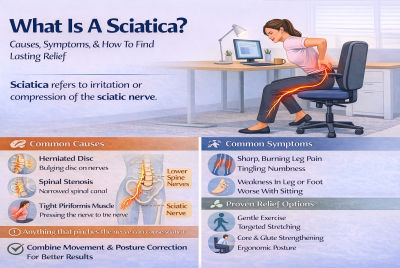Cold Therapy for Sciatica Pain
Understanding Cold Therapy for Sciatica Relief
Discover how cold therapy for sciatica pain can offer fast relief by reducing inflammation and numbing discomfort. Learn safe tips and techniques! Dealing with sciatica pain can be incredibly frustrating. I’ve been there—feeling that sharp, shooting pain radiating from my lower back down through my legs. It’s debilitating, isn’t it? One approach that I often recommend for immediate relief is cold therapy. It’s simple, effective, and easy to use from the comfort of your home. But what exactly is cold therapy, and how can it help with sciatica pain? Let’s dive in.
What is Sciatica?
Sciatica refers to pain that originates along the sciatic nerve, which runs from the lower back down through the hips, buttocks, and legs. It’s a condition that often stems from irritation or compression of the sciatic nerve, causing discomfort that ranges from mild to severe.
Common Causes of Sciatica Pain
The leading cause of sciatica is a herniated disc pressing on the sciatic nerve. Other causes include bone spurs, spinal stenosis, or even muscle imbalances. Regardless of the cause, the end result is often the same—nagging pain that makes it difficult to stand, sit, or move comfortably.
Symptoms Associated with Sciatica
The primary symptom of sciatica is sharp, radiating pain that typically affects one side of the body. You might also experience numbness, tingling, or muscle weakness in the affected leg.
Ice or Heat – Which One is Best for Sciatica Pain?
What is Cold Therapy?
Cold therapy, also known as cryotherapy, involves the application of ice or cold substances to reduce pain and inflammation. When applied to the affected area, cold therapy helps constrict blood vessels, slowing blood flow and reducing swelling. It’s a go-to method for many types of injuries, including sciatica.
How Cold Therapy Works for Pain Relief
When you apply something cold to your lower back or the affected leg, it reduces blood flow to the area, which decreases inflammation. The cold also numbs the area, blocking the pain signals that are traveling to your brain.
Cold Therapy vs Heat Therapy: Which is Better for Sciatica?
You might be wondering whether to use cold or heat for sciatica. While both have their benefits, cold therapy is particularly useful during the acute phase—when inflammation is present. Heat therapy, on the other hand, works better once the initial inflammation has subsided, helping to relax tight muscles and improve blood flow.
Why Cold Therapy is Effective for Sciatica
Cold therapy isn’t just about numbing the pain; it targets the root causes of sciatica, making it an excellent choice for flare-ups.
Reducing Inflammation with Cold Therapy
One of the key benefits of cold therapy is its ability to reduce inflammation. Sciatica is often caused by swelling around the nerve, and applying ice to the area can help minimize this.
Numbing the Pain: How Cold Therapy Blocks Pain Signals
The cold sensation interrupts the nerve signals that transmit pain to your brain, providing almost immediate relief. It’s like hitting the pause button on your discomfort.
Cold Therapy for Muscle Spasms and Sciatica
Cold therapy can also help with muscle spasms that often accompany sciatica. By reducing inflammation, cold therapy helps your muscles relax, which in turn alleviates the pressure on the sciatic nerve.
Types of Cold Therapy for Sciatica
There are several ways to apply cold therapy, and the good news is that you probably have everything you need at home.
Ice Packs
This is the most common form of cold therapy. You can use a store-bought ice pack or simply make your own by wrapping ice cubes in a towel.
Cold Compresses
A cold compress is a bit more flexible than an ice pack, making it easier to mold around areas like your lower back or hips.
Cryotherapy
If you want to take it a step further, cryotherapy chambers, where your body is exposed to extremely cold temperatures for a short time, are becoming more popular. While this option can be more expensive, it’s highly effective for severe pain.
How to Apply Cold Therapy for Sciatica
Using cold therapy effectively involves more than just slapping an ice pack on your back. Here’s how to do it properly.
Best Practices for Using Ice Packs
Wrap the ice pack in a thin towel to prevent direct contact with your skin, which can cause frostbite. Apply it to the painful area for about 15-20 minutes at a time.
How Long Should Cold Therapy Last?
Each session should last no longer than 20 minutes. Any longer, and you risk damaging your skin. Afterward, give the area a break to allow your tissues to return to normal temperature.
Frequency of Cold Therapy Sessions
You can use cold therapy several times a day, especially during the first 48 hours of a sciatica flare-up. Just be sure to space out your sessions to avoid skin damage.
Precautions to Take While Using Cold Therapy
While cold therapy is generally safe, there are a few precautions to keep in mind.
Avoiding Skin Damage
Never apply ice directly to your skin. Always use a barrier like a towel or cloth to prevent frostbite or skin irritation.
Who Should Avoid Cold Therapy?
If you have conditions like poor circulation or nerve damage, consult your doctor before using cold therapy. It may not be suitable for everyone.
When to Combine Cold Therapy with Other Treatments
Cold therapy works best when combined with other treatments for sciatica.
Cold Therapy and Physical Therapy
Using cold therapy before or after physical therapy can help minimize soreness and inflammation, making your sessions more effective.
Cold Therapy and Stretching Exercises
After a cold therapy session, you might feel more comfortable performing gentle stretching exercises that can help relieve pressure on the sciatic nerve.
FAQs Related to Cold Therapy for Sciatica Pain
How quickly does cold therapy work for sciatica pain?
Cold therapy typically provides relief within a few minutes of application, though it may take a few sessions to reduce inflammation fully.
Can cold therapy be used for long-term sciatica relief?
Cold therapy is best used for short-term flare-ups, while long-term relief often requires a combination of treatments.
What’s the difference between ice packs and cold compresses?
Ice packs are usually firmer and hold cold for longer, while cold compresses are more flexible, making them easier to mold to your body.
How long should I wait between cold therapy sessions?
You should wait at least 1 hour between sessions to avoid overexposure to cold.
Can I use cold therapy during a sciatica flare-up?
Yes, cold therapy is particularly effective during flare-ups when inflammation is at its worst.
Are there any risks of using cold therapy for sciatica?
Risks include frostbite or skin damage if cold therapy is applied for too long or without a protective barrier. Always use cold therapy safely.
Cold Therapy for Sciatica Pain – Conclusion
In conclusion, cold therapy can be a quick and effective way to manage sciatica pain, especially during flare-ups. Reducing inflammation and numbing the pain offers immediate relief while addressing the root causes of your discomfort. Just remember to use it safely—don’t overdo it, and make sure you’re protecting your skin. Give cold therapy a try the next time sciatica strikes, and you might find that it’s exactly what you need for fast relief.
Disclaimer
This article is for informational purposes only and is not a substitute for professional medical advice, diagnosis, or treatment. Always consult with your healthcare provider before starting a new exercise or stretching routine, especially if you have existing back or nerve conditions.
👉 Explore more:





